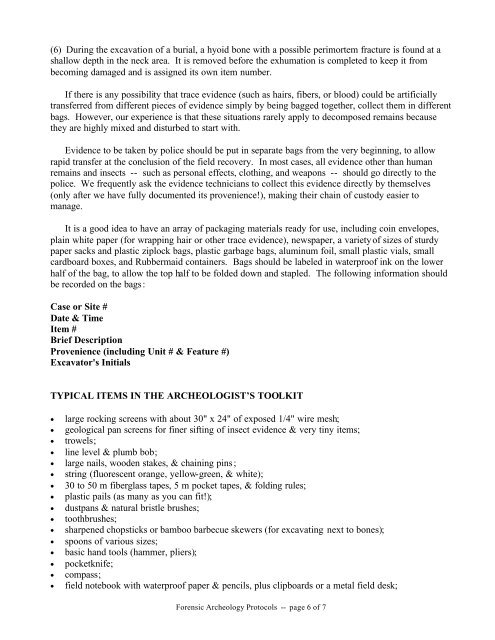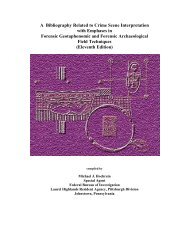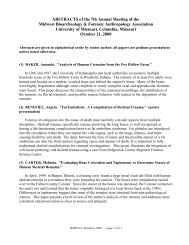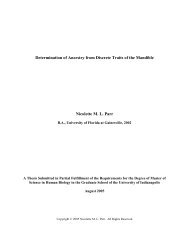Forensic Archeology Protocols Used by the University of Indianapolis
Forensic Archeology Protocols Used by the University of Indianapolis
Forensic Archeology Protocols Used by the University of Indianapolis
You also want an ePaper? Increase the reach of your titles
YUMPU automatically turns print PDFs into web optimized ePapers that Google loves.
(6) During <strong>the</strong> excavation <strong>of</strong> a burial, a hyoid bone with a possible perimortem fracture is found at a<br />
shallow depth in <strong>the</strong> neck area. It is removed before <strong>the</strong> exhumation is completed to keep it from<br />
becoming damaged and is assigned its own item number.<br />
If <strong>the</strong>re is any possibility that trace evidence (such as hairs, fibers, or blood) could be artificially<br />
transferred from different pieces <strong>of</strong> evidence simply <strong>by</strong> being bagged toge<strong>the</strong>r, collect <strong>the</strong>m in different<br />
bags. However, our experience is that <strong>the</strong>se situations rarely apply to decomposed remains because<br />
<strong>the</strong>y are highly mixed and disturbed to start with.<br />
Evidence to be taken <strong>by</strong> police should be put in separate bags from <strong>the</strong> very beginning, to allow<br />
rapid transfer at <strong>the</strong> conclusion <strong>of</strong> <strong>the</strong> field recovery. In most cases, all evidence o<strong>the</strong>r than human<br />
remains and insects -- such as personal effects, clothing, and weapons -- should go directly to <strong>the</strong><br />
police. We frequently ask <strong>the</strong> evidence technicians to collect this evidence directly <strong>by</strong> <strong>the</strong>mselves<br />
(only after we have fully documented its provenience!), making <strong>the</strong>ir chain <strong>of</strong> custody easier to<br />
manage.<br />
It is a good idea to have an array <strong>of</strong> packaging materials ready for use, including coin envelopes,<br />
plain white paper (for wrapping hair or o<strong>the</strong>r trace evidence), newspaper, a variety <strong>of</strong> sizes <strong>of</strong> sturdy<br />
paper sacks and plastic ziplock bags, plastic garbage bags, aluminum foil, small plastic vials, small<br />
cardboard boxes, and Rubbermaid containers. Bags should be labeled in waterpro<strong>of</strong> ink on <strong>the</strong> lower<br />
half <strong>of</strong> <strong>the</strong> bag, to allow <strong>the</strong> top half to be folded down and stapled. The following information should<br />
be recorded on <strong>the</strong> bags:<br />
Case or Site #<br />
Date & Time<br />
Item #<br />
Brief Description<br />
Provenience (including Unit # & Feature #)<br />
Excavator's Initials<br />
TYPICAL ITEMS IN THE ARCHEOLOGIST’S TOOLKIT<br />
• large rocking screens with about 30" x 24" <strong>of</strong> exposed 1/4" wire mesh;<br />
• geological pan screens for finer sifting <strong>of</strong> insect evidence & very tiny items;<br />
• trowels;<br />
• line level & plumb bob;<br />
• large nails, wooden stakes, & chaining pins;<br />
• string (fluorescent orange, yellow-green, & white);<br />
• 30 to 50 m fiberglass tapes, 5 m pocket tapes, & folding rules;<br />
• plastic pails (as many as you can fit!);<br />
• dustpans & natural bristle brushes;<br />
• toothbrushes;<br />
• sharpened chopsticks or bamboo barbecue skewers (for excavating next to bones);<br />
• spoons <strong>of</strong> various sizes;<br />
• basic hand tools (hammer, pliers);<br />
• pocketknife;<br />
• compass;<br />
• field notebook with waterpro<strong>of</strong> paper & pencils, plus clipboards or a metal field desk;<br />
<strong>Forensic</strong> <strong>Archeology</strong> <strong>Protocols</strong> -- page 6 <strong>of</strong> 7








